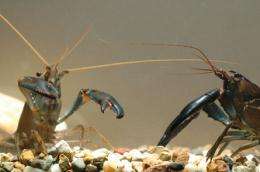March 15, 2012 report
Research duo finds crayfish use deception to ward off other males

(PhysOrg.com) -- Because we’re so smart compared to other species that live on this planet, people tend to ascribe certain abilities as innately human. One of these traits is the ability to lie or cheat. This is because doing so seems to imply a high order of intelligence. Unfortunately, as with many other traits that have once been thought uniquely human, lying, or bluffing appears to occur in other species as well, or at least in one, the lowly male crayfish. In a recent study, Michael Angilletta from Arizona State University and Robbie Wilson of the University of Queensland, found that male crayfish use claw size to bluff their way out of fights with other males. They have published their observations in the Royal Society journal, Biology Letters.
Crayfish, as most who have ever seen them can attest, are naturally aggressive. If you stick your hand in the water, rather than run or hide, a crayfish will grab your fingers with its sharp claws and try to defeat you. Thus, it should come as no surprise that they are just as nasty regarding one another. Upon two males meeting, their natural inclination is to start fighting. But then, sometimes, they don’t. Evolution has added a layer of protection to keep them from completely wiping out their own species by endowing males with different sized claws. Oddly, instead of jumping into action, as might be expected, two males will first size one another up. They’ll lift their claws to show the other how big they are, then lay them down so the other can poke and prod them a little. If one is satisfied that the other has bigger claws, he will leave the scene and a fight will be avoided, which is a good thing, because when they do fight, limbs can be severed and sometimes one or the other ends up dead.
But there is more to the story as Angilletta and Wilson found out, because all is not as it seems. They found after studying 97 of the males in action on North Stradbroke Island in Queensland, that claw size doesn’t equate to strength. Some males with large claws had weak muscles, while some with smaller claws had strong muscles; and in crawfish, muscle is more important because it can mean the difference between causing an annoying pinch versus severing a limb or other important body part.
The research duo surmise that the crayfish are fully aware of the actual strength of their pinch and thus resort to bluffing if their muscles aren’t up to snuff when they run into another male with smaller, but potentially stronger claws. And because the smaller clawed rival falls for it as much as 80% of the time, many unnecessary fights and the carnage they cause can be avoided.
Thus, clearly humans, are not the only species able to bluff their way out of fight.
More information: Cryptic asymmetry: unreliable signals mask asymmetric performance of crayfish weapons, Biology Letters, Published online before print March 14, 2012, doi: 10.1098/rsbl.2012.0029
Abstract
Animals commonly use their limbs as signals and weapons during territorial aggression. Asymmetries of limb performance that do not relate to asymmetries of limb size (cryptic asymmetry) could substantially affect disputes, but this phenomenon has not been considered beyond primates. We investigated cryptic asymmetry in male crayfish (Cherax dispar), which commonly use unreliable signals of strength during aggression. Although the strength of a chela can vary by an order of magnitude for a given size, we found repeatable asymmetries of strength that were only weakly related to asymmetries of size. Size-adjusted strength of chelae and the asymmetry of strength between chelae were highly repeatable between environmental conditions, suggesting that asymmetries of strength stemmed from variation in capacity rather than motivation. Cryptic asymmetry adds another dimension of uncertainty during conflict between animals, which could influence the evolution of unreliable signals and morphological asymmetry.
Journal information: Biology Letters
© 2011 PhysOrg.com

















